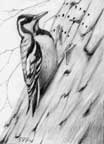|
 Earth Journal Earth Journal
by Gary Pendleton |
 Can You Say Yellow-Bellied Sapsucker? Can You Say Yellow-Bellied Sapsucker?
It is probably inevitable if you spend a significant amount of time watching birds. You will be casually speaking to an acquaintance about what you did and what you saw. You will mention, with a straight face, the name of a particular bird that you encountered during an outing. You will hear yourself say the words yellow-bellied sapsucker. You are now an official bird-nerd. Oh well, things could be worse.
There are four species of sapsuckers worldwide, and all spend summer and winter in part of North America. The yellow-bellied is the only eastern species. It breeds in the northeastern U.S. and Canada but winters in the Mid-Atlantic and Southeast.
Have you noticed that some trees have rows of small, regularly spaced holes that look like they were made by a drill? If so, you were looking at the product of sapsuckers. These birds do indeed eat the sap that oozes from the holes, using specialized tongues with brush-like modifications. Other woodpeckers and songbirds also eat sap and insects attracted to the sap.
The birds in question do indeed have pale-yellow, sulfur-colored bellies. As with some other woodpeckers, there is some red color on the head, the forehead in this case. Male yellow-bellied sapsuckers also have red throats, while the females have white throats. The easiest way to quickly differentiate sapsuckers from other woodpeckers is the stripe of white plumage on the wings.
Most other types of woodpeckers have a very clean look about them. These other birds typically seem to have snowy white feathers neatly arranged around glossy black feathers, forming interesting geometric patterns in the plumage. In the case of the yellow-bellied sapsucker, though, the plumage often looks irregular, and the white spots look dingy and spotty as if all that sticky sap attracts dirt. I can find nothing in my library of bird books that says anything about lack of fastidiousness in the sapsuckers, so I am happy to report that the birds should not be held in low regard for poor personal habits.
Speaking of bird books reminds me of the time I was reading about shore birds in my field guide. The text described a particular bird as having “streaky brown underparts." I misread that passage as “streaky brown underpants." How embarrassing! At least the yellow-bellied sapsucker - despite its goofy name and unkempt appearance - doesn't have the burden of disclaiming that odious assertion.
Sapsuckers are uncommon but regular visitors to the wooded areas of the Mid-Atlantic region. Locally, they can be found quietly drilling rows of evenly spaced holes in many kinds of trees during the months between October and March.
|


 Earth Journal
Earth Journal Can You Say Yellow-Bellied Sapsucker?
Can You Say Yellow-Bellied Sapsucker?